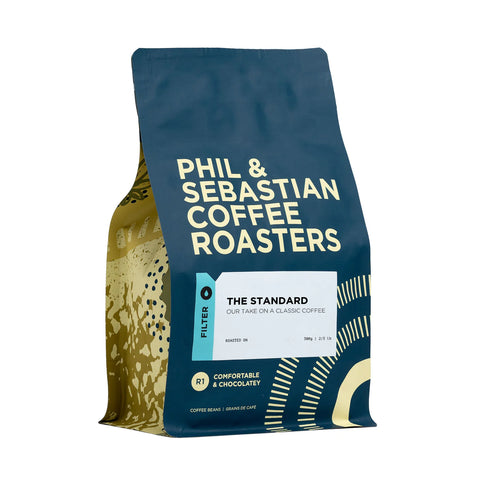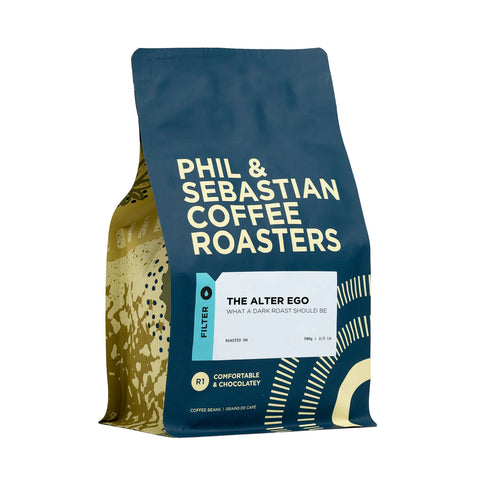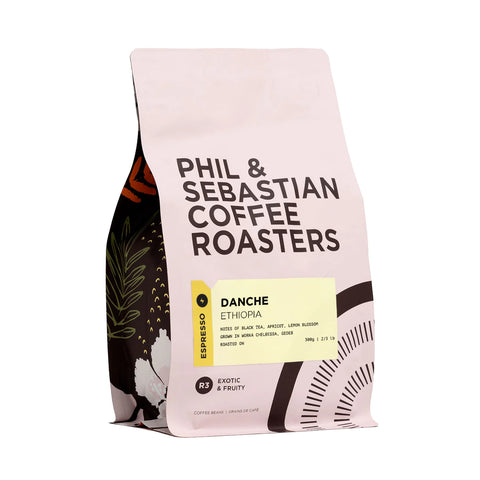The Roastery

Phil Robertson and Sebastian Sztabzyb met in 1996 at the University of Calgary. They were both studying engineering when they were paired up as lab partners and bonded over a mutual love of fine food and wine.
In 2002, they developed an interest in espresso and when Phil inherited David Schomer's book Espresso Coffee: Professional Techniques, the duo dove deep into the science behind pulling a perfect shot.
Sztabzyb's kitchen served as a makeshift tasting lab, but the pair wanted to taste the coffee they had been reading about. They took a road trip to Seattle to visit Vivace, David Schomer's small cafe and roastery. After driving from Calgary to Seattle through a March snowstorm, they ordered a cappuccino and an espresso.
"Those drinks, combined with the relaxed vibe and the tattooed yet knowledgeable baristas, were what finally brought us to the realization that we needed to open a place of our own in Calgary," Robertson explained.
Since then, Robertson and Sztabzyb have opened nine locations throughout Calgary and have become synonymous with specialty coffee in Canada. We speak to many roasters, who often tell us that the first coffee that got them interested in specialty coffee was one they tried from Phil & Sebastian.
Despite their success, the duo are far from done with their single-minded pursuit of a better cup of coffee.
"It would be really boring to be mediocre or to be finished in our quest for making great coffee. It gets me out of bed, knowing it's a long way to go. We have tasted glimpses of near perfection - the question is, how do we get it to be consistently great?" Sztabzyb explained.
The pursuit of perfection. That would be a daunting task for most folks; however, Phil and Sebastian aren't like most people. Before the road trip to Seattle, they had a comfortable, well-paying job at an engineering firm that any new graduate could be proud of. But that wasn't for them. So, the ambitious coffee-loving pair left one industry and went head first into another.
"The motivation was in building something and doing something interesting & inspiring as opposed to sitting in front of a computer all day writing code, never seeing the light of day. For us, coffee was an absolute fascination and intense hobby compared to the "going nowhere" feeling we were experiencing day-to-day," Sztabzyb furthered.
The Cafes
Green sourcing
Phil & Sebastian work closely with many of the farmers they source from. From visiting the farms and developing long-standing relationships with producers, they aim to go beyond direct trade with their partners.
All their coffees are carefully sourced and sustainably compensated to ensure producers are able to produce high-quality coffee. From farm to roasting, they work to realize the potential of the coffee and make good coffee extraordinary. They always feature coffees in season and sustainably sourced.
"In meeting the farmers, we hope to discover that they, too, have a shared vision with us — an interest in improvement and an appreciation for the work it takes to make it happen. That, we would say, is the most important quality," Sztabzyb shared.
The Coffee profiles
Phil & Sebastian break their coffee profiles down into three main categories:
R3 - These coffees are chocolatey and conformable. They are the classic everyday crowd-pleasers.
R2 - These coffees are approachable and nuanced. They are delicate and thought-provoking.
R1 - These coffees are exotic and fruity. They have vibrant and inspiring flavours.
Their menu rotates seasonally to feature single-origin coffees. But, in their R1 category, they have consistent coffee profiles. These coffees are single-origin as well, and their components change seasonally, but their profile remains the same. Because of their long relationships with producers, you will often see coffees returning each year in addition to new offers.
These coffees are:
The Standard/ The Standard Espresso

This coffee is their take on a classic cup.
Tasting notes: sweet, chocolaty and nutty
The Alter Ego

This coffee is their take on a dark roast– what a dark roast should be.
Tasting notes: cocoa, caramel and nuts
The Doppelganger Espresso

This coffee is their version of a dark roast espresso.
Tasting notes: chocolate, nougat and caramel.
Green Freezing
There are differing opinions about the aging and degrading of green coffee, and every roaster has their own way of trying to stop the clock. At Phil & Sebastian Coffee Roasters, they've invested in freezing their green coffee.
If you've ever scrolled through the Phil & Sebastian website, I am sure you have come across the phrase, "This green coffee was frozen immediately on its arrival in Calgary to preserve freshness."
We chatted with Phil Robertson to learn what exactly this means.
"Freezing green is one of the most important things that we do for quality. The real reason for doing it is quality preservation," Robertson began.
So here is how it works: the shipping containers holding their green coffee are delivered to their freezing space (a third-party freezing warehouse used to store frozen food). Once all the bags are removed and put on pallets, they are put in a special chamber that rapidly freezes the green. Once frozen, they are put in the warehouse, where they remain until they are ready to be roasted. Once a week, the coffee that will be roasted within that same week is released from the warehouse and given three days to defrost.
They got the idea of freezing their green from George Howell, founder of George Howell Coffee in the United States. Howell is widely considered a pioneer of specialty coffee.
As a vocal advocate for freezing green coffee, Howell has hosted events where he will release vintage coffees– between 5-6 years old– from his "frozen library." Though recognizing that it could make his competition stiffer, Howell is outspoken about wanting other roasters to freeze their green coffee.
Of course, there are pros and cons to the practice.
"Freezing is very expensive, and you can make an argument about the carbon footprint; we are looking for ways to lower that. But from a quality standpoint, I have never seen anything that can touch it," Robertson explained.
Since coffee is seasonal, but we want to drink it all year round, roasters have always been posed with the challenge of maintaining the freshness of their coffee. Something Robertson, like all roasters, is keenly aware of.
"The hardest time for coffee is February and March because you haven't got your fresh crop coffees from the northern hemisphere, and the coffee from the southern hemisphere is aging. But with green freezing, you can basically stop the clock. So once we get the coffee, I can tell you with a high level of certainty that whether you order it today or in 6 months, it will taste the same."
Recent features in The Roasters Pack
Umaña Brothers

This white honey processed Costa Rican coffee has tasting notes of chocolate, vanilla wafer and apricot and fits in Phil & Sebastian’s R2 category.
“There are lots of chocolate notes in the cup; it has a heavier body that is very silky. It has sweet vanilla wafter flavours when hot, but as it cools, these develop into delicate apricot-like notes.” - Phil Robertson
Danche

This washed Ethiopian coffee has tasting notes of black tea, jasmine and peach tea and fits in Phil & Sebastian’s R3 category.
"When the coffee is hot, it has a lot of black tea notes and a bit of lemon. Then, as it cools, the complexity opens up and develops into a floral jasmine flavour that finishes with a peach tea note. It has a light body and becomes very perfumed as it cools.” - Phil Robertson
Phil & Sebastian work closely with farms in Ethiopia and have been visiting them for 12 years. Phil Robertson explained to us they chose to source this coffee and how it represents a small area in the Gedeb region.
"I have been going to Ethiopia for 12 years, and this particular area of Gedeb has been exciting for me for a long time. I was specifically fascinated by Danche as it's from a washing station that is a little bit further up the mountain, so it's a bit higher in altitude and a bit more remote. This means that the washing station has lower volumes of coffee as producers would rather walk down the mountain to deliver coffee rather than up. This means that the coffee processed there is really from that tight, localized area. And so you get these specific, regional characteristics that are really interesting, and you also get a single core varietal. The coffee is about 90% Kurume and 10% Dega."






